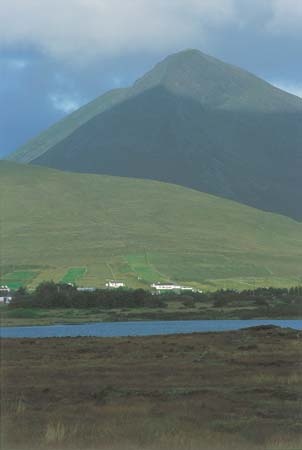Mayo
county, Ireland
Irish Maigh Eo (“Plain of the Yew Trees”)
 county in the province of Connaught, western Ireland. Mayo is bounded by the Atlantic Ocean (north and west) and by Counties Sligo (northeast), Roscommon (east), and Galway (southeast and south). Mayo's extensive coastline is wild and broken, with many inlets from Killala Bay in the north to Killary Harbour in the southwest. Westport and Ballina are port towns, and there are numerous islands and inland lakes. Stretching east and north from Lough (Lake) Carrowmore is the largest expanse of bog in Ireland, 200 square miles (520 square km) in area. The principal rivers in Mayo are the Moy and the Errif. The low peaks of Nephin (2,646 feet 【807 metres】) and Croagh Patrick (2,510 feet 【765 metres】) dominate the landscape; and Mweelrea (2,688 feet 【819 metres】), to the north of Killary Harbour, is the highest mountain in Connaught.
county in the province of Connaught, western Ireland. Mayo is bounded by the Atlantic Ocean (north and west) and by Counties Sligo (northeast), Roscommon (east), and Galway (southeast and south). Mayo's extensive coastline is wild and broken, with many inlets from Killala Bay in the north to Killary Harbour in the southwest. Westport and Ballina are port towns, and there are numerous islands and inland lakes. Stretching east and north from Lough (Lake) Carrowmore is the largest expanse of bog in Ireland, 200 square miles (520 square km) in area. The principal rivers in Mayo are the Moy and the Errif. The low peaks of Nephin (2,646 feet 【807 metres】) and Croagh Patrick (2,510 feet 【765 metres】) dominate the landscape; and Mweelrea (2,688 feet 【819 metres】), to the north of Killary Harbour, is the highest mountain in Connaught. Castlebar is the county town (seat) and an urban district, as are Ballina and Westport. Ballina is the seat of the Roman Catholic bishop of Killala.
In the rugged mountains of the north and west, the farms are small, and much of the population supplements its earnings by migration to Great Britain. About one-fourth of the population are employed in agriculture. Cattle for the British market and sheep and pigs are raised extensively. Tourism is an important source of income, and the area is particularly attractive to fishermen and bird hunters. There is some light industry in the county, including flour milling and textile manufacturing.
The county is rich in Neolithic remains and has strong associations with the early Irish ministry of Saint Patrick (Patrick, Saint). There are round towers at Killala and Turlough. Ballintober Abbey, founded in 1216, is still in use as a church. Monastic ruins are widespread.
At the close of the 12th century, the territory that now constitutes County Mayo was granted by King John of England to the Norman William de Burgh, but Mayo remained loosely subject to the Gaelic overlordship of O'Donnell, chief of Tyrconnell. In the 14th century the land passed to a branch of the de Burgh family known as MacWilliam Iochtair. In 1603 Theobald Burke, of the MacWilliam Iochtair, surrendered his lands and received them back to hold with the title of Viscount Mayo. Area 2,157 square miles (5,586 square km). Pop. (2002) 117,446; (2006) 123,839.
people
Indian people centred in southern Sonora and northern Sinaloa states on the west coast of Mexico. They speak a dialect of the Cahita language, which belongs to the Uto-Aztecan language family.
The history of the Mayo people prior to the Spanish conquest of Mexico is obscure. In the early 17th century they readily allied themselves with the Spaniards against their northern neighbours, the Yaqui. But gradual Spanish encroachment on their land drove the Mayo to revolt in 1740 and subsequently before they were permanently pacified in the 1880s by Mexico's central government.
The Mayo are concentrated in the fertile irrigated valleys of the Mayo and Fuerte rivers, which are set in the midst of semidesert terrain that supports thorny scrubland and cactus. The Mayo are settled agriculturalists whose traditional crops of corn (maize), beans, and squash have given way in part to such crops as cotton, wheat, and safflower (for oil). The Mayo combine Roman Catholicism with aboriginal religious practices. They numbered about 80,000 in the late 20th century.
- blimp
- blind fish
- Blind Lemon Jefferson
- blindman's buff
- blind mole rat
- blindness
- blind snake
- blind spot
- blind staggers
- Blind Willie Johnson
- Bliss Carman
- Bliss Classification
- Bliss, Gilbert Ames
- Bliss, Nathaniel
- Bliss Perry
- Bliss, Sir Arthur
- Bliss, Tasker Howard
- Bliss, William D P
- blister
- blister beetle
- blister rust
- Blitar
- blitzkrieg
- Blitzstein, Marc
- Blix, Hans